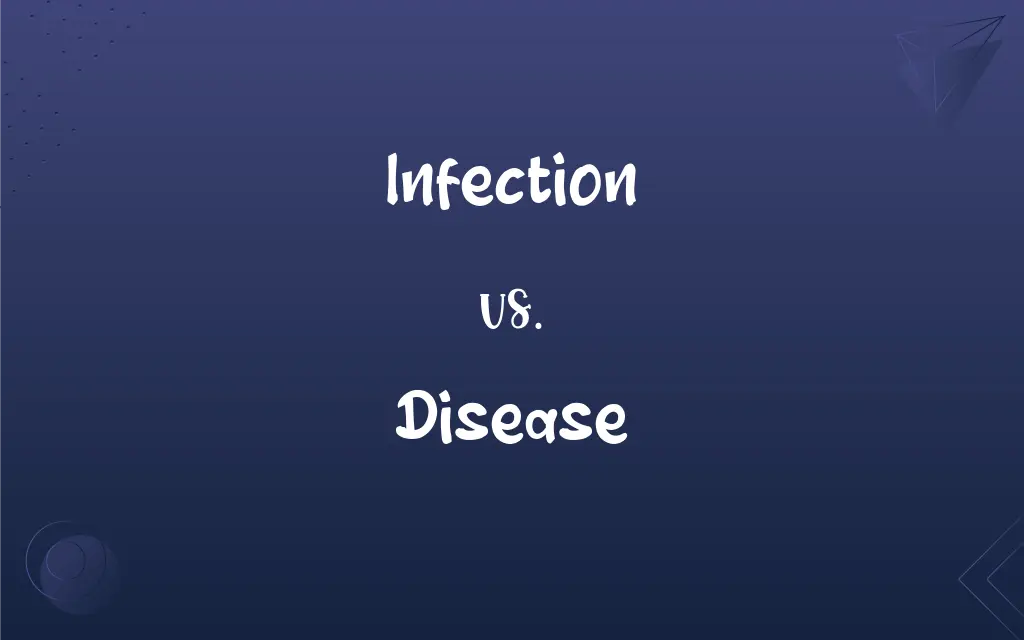Infection vs. Disease: What's the Difference?
Edited by Janet White || By Harlon Moss || Updated on October 18, 2023
An infection occurs when harmful microorganisms invade a host, while a disease manifests as clinical symptoms and signs in the body.

Key Differences
Infection and disease are terms frequently used in the realm of health and medicine, often interchangeably. However, there's a nuanced difference between the two. An infection refers to the colonization or invasion of the body by harmful microorganisms, such as bacteria, viruses, fungi, or parasites.
Disease, on the other hand, represents any deviation from or interruption of the normal structure or function of any part, organ, or system of the body. This can be caused by various factors, including infections, genetics, lifestyle choices, or a combination of these.
It's possible to have an infection without it leading to a disease. For instance, many individuals carry certain bacteria in their body without experiencing any negative symptoms or ailments. This state is termed asymptomatic infection.
Conversely, not all diseases stem from infections. For example, autoimmune diseases, genetic disorders, and many types of cancer arise from non-infectious causes. Yet, infections can sometimes lead to diseases, as seen in the case of the human immunodeficiency virus (HIV) infection leading to acquired immunodeficiency syndrome (AIDS).
The line between infection and disease becomes evident in the realm of treatment and prevention. While infections might be treated with antivirals or antibiotics, diseases could require a broader range of interventions, including lifestyle changes, surgeries, or other medications.
ADVERTISEMENT
Comparison Chart
Definition
Invasion of the body by harmful microorganisms.
Any deviation from the normal function or structure of the body.
Cause
Microorganisms like bacteria, viruses, fungi, or parasites.
Various factors including infections, genetics, or lifestyle.
Symptomatic Status
Can be asymptomatic.
Typically presents with symptoms or signs.
Examples
Influenza, Staph infection.
Diabetes, arthritis, cancer.
Treatment
Often involves antimicrobial agents.
Can include medications, lifestyle changes, or surgeries.
ADVERTISEMENT
Infection and Disease Definitions
Infection
Can be caused by bacteria, viruses, fungi, or parasites.
This type of infection is viral in nature.
Disease
Can be caused by internal or external factors.
The disease was genetic in origin.
Infection
Invasion of the body by harmful microorganisms.
She was diagnosed with a bacterial infection.
Disease
A disorder affecting the body's normal function or structure.
Heart disease affects millions worldwide.
Infection
Might not always lead to disease.
He carried the infection but never showed any symptoms.
Disease
Encompasses infections, genetic disorders, and more.
Lung disease can be caused by smoking or infections.
Infection
A condition where pathogens colonize a host.
The wound led to a severe infection.
Disease
Might have known or unknown etiologies.
The exact cause of the disease remained unknown.
Infection
Can be localized or systemic.
The infection remained localized to his foot.
Disease
Often diagnosed through clinical symptoms and signs.
The disease was evident due to the persistent cough.
Infection
The invasion of bodily tissue by pathogenic microorganisms that proliferate, resulting in tissue injury that can progress to disease
Measures taken by the hospital to prevent infection.
Disease
An abnormal condition of a part, organ, or system of an organism resulting from various causes, such as infection, inflammation, environmental factors, or genetic defect, and characterized by an identifiable group of signs, symptoms, or both.
Infection
The entry or placement, as by injection, of a microorganism or infectious agent into a cell or tissue.
Disease
A condition or tendency, as of society, regarded as abnormal and harmful.
FAQs
What is a disease?
A disease is a pathological condition in an organism that results in bodily dysfunction due to an underlying cause, which can be infections, genetic mutations, environmental factors, and more.
Can all infections lead to disease?
No, not all infections result in disease. Some infections are asymptomatic, meaning they don’t cause noticeable symptoms or illness.
Can a single microorganism cause multiple diseases?
Yes, certain microorganisms can cause different diseases depending on the body part they infect or the individual's immune response.
What is an infection?
An infection occurs when harmful microorganisms like bacteria, viruses, fungi, or parasites enter and multiply in the body.
Can infections be beneficial?
Some infections can be beneficial by boosting the immune system or outcompeting more harmful pathogens. For instance, certain bacterial infections in the gut can promote health.
What is the difference between chronic and acute diseases?
Acute diseases have a sudden onset and may resolve quickly, whereas chronic diseases persist over long periods, sometimes for a lifetime.
What are some examples of non-infectious diseases?
Examples include diabetes, heart disease, and certain types of cancer.
Can diseases spread like infections?
Infectious diseases can spread from person to person, but non-infectious diseases generally do not spread in the same way.
What is the role of vaccines in preventing infections?
Vaccines stimulate the immune system to recognize and fight specific pathogens, reducing the risk of infection.
Why do some infections recur?
Some infections recur because of the persistence of the pathogen in the body, a weakened immune response, or reinfection from an external source.
Can infections lead to long-term diseases?
Yes, some infections can trigger chronic conditions or diseases. For example, certain viral infections can increase the risk of developing specific cancers.
Is a virus an infection or a disease?
A virus can cause an infection, which in turn can lead to a disease. The virus itself is not a disease.
How are infections diagnosed?
Infections can be diagnosed using various methods such as blood tests, tissue samples, and imaging studies.
How can diseases be prevented?
Disease prevention can involve a range of strategies, including vaccination, good hygiene practices, healthy lifestyle choices, and early detection.
What's the connection between infections and antibiotics?
Antibiotics are drugs designed to treat bacterial infections. They work by killing bacteria or inhibiting their growth.
How is an infectious disease different from other diseases?
Infectious diseases are caused specifically by pathogens (like bacteria or viruses), whereas other diseases can have non-infectious origins, such as genetic or environmental factors.
Can a disease exist without any noticeable symptoms?
Yes, some diseases can be asymptomatic, meaning they present without noticeable symptoms, especially in their early stages.
What is a secondary infection?
A secondary infection is an infection that occurs during or after treatment of another, primary infection, typically due to a weakened immune system.
Why is it important to differentiate between infection and disease?
Differentiating helps in understanding the root cause, guiding appropriate treatment, and implementing preventive measures.
How does the body respond to infections?
The body responds to infections through the immune system, which identifies, attacks, and removes pathogens.
About Author
Written by
Harlon MossHarlon is a seasoned quality moderator and accomplished content writer for Difference Wiki. An alumnus of the prestigious University of California, he earned his degree in Computer Science. Leveraging his academic background, Harlon brings a meticulous and informed perspective to his work, ensuring content accuracy and excellence.
Edited by
Janet WhiteJanet White has been an esteemed writer and blogger for Difference Wiki. Holding a Master's degree in Science and Medical Journalism from the prestigious Boston University, she has consistently demonstrated her expertise and passion for her field. When she's not immersed in her work, Janet relishes her time exercising, delving into a good book, and cherishing moments with friends and family.






























































